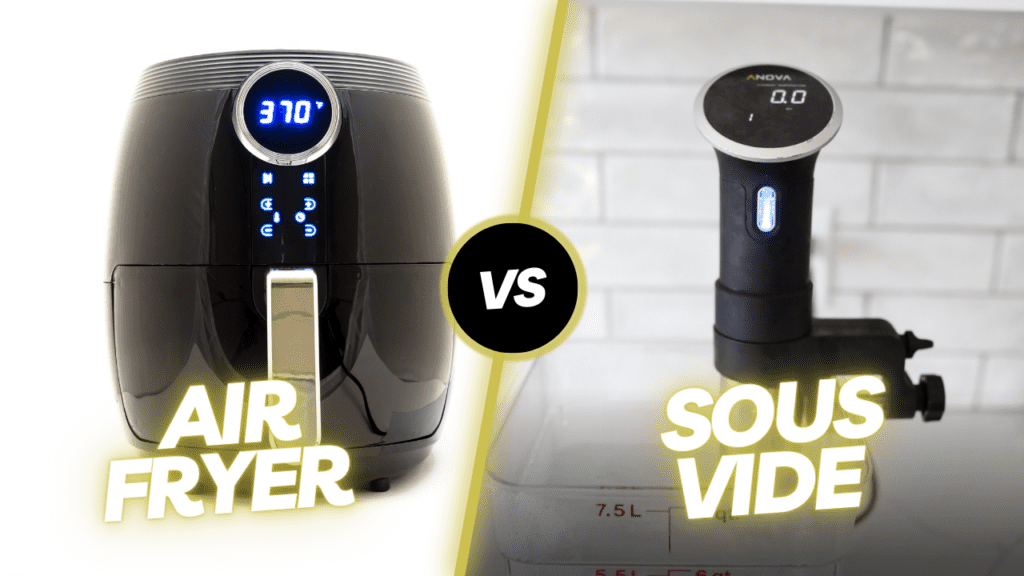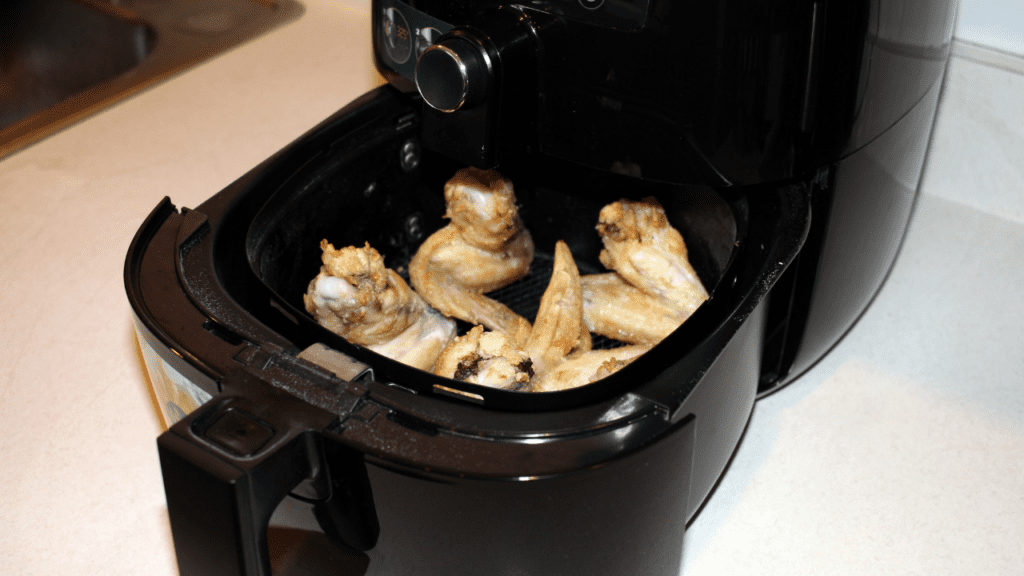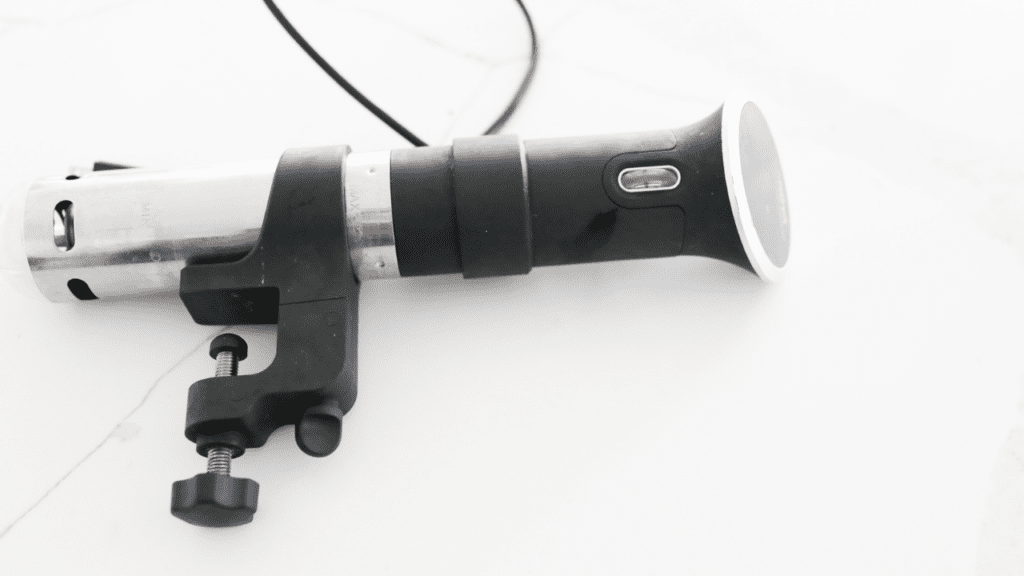Sous vide cookers and air fryers are two of the most popular cooking appliances to make delicious food. Today we’ll compare sous vide vs air fryer in terms of their benefits and drawbacks so you can make an informed decision on sous vide cookers and air fryers. I’ll help you figure out what type of appliance will best suit your needs as a home chef.
With sous vide, you have precise temperature control, so your food is perfectly cooked every time. Air fryers allow you to cook all sorts of food without the use of oil, giving you healthier meals.

Table of Contents
What Is An Air Fryer and How Does It Work?
Air fryers could be described as a cross between a countertop convection oven and a deep fryer. Using little or no oil, these appliances mimic the results of deep fat frying by blowing hot air around food that is held in a “fryer basket.”
Increasingly popular in American homes, air fryers are versatile devices that can cook all kinds of food, including roasted vegetables, fish, and fries, to name a few.
They have many attractive features that are similar to replacing several appliances, including fryers, steamers, and even entire ovens.
Some of my favorite foods to make are of course fried foods like french fries, chicken nuggets, and crispy-fried chicken skin. They can even do baked foods, like cookies!
They work by circulating hot air around the food held in the food basket. A heating element on top of the fryer heats the air and an internal fan circulates the heat around food. It is the hot air that crisps the food, giving it that “deep-fried” crispy texture and flavor.

Let’s take a look at some advantages and disadvantages of air fryers.
Air Fryer Benefits
- Healthy – Air fryers use a mere tablespoon of oil, if that, to produce meals that traditionally have required deep fat frying. This oil is circulated with the hot air and any excess drains away.
- Efficient – Unlike conventional ovens or traditional deep fryers, there is little preheating involved to save on cook times. With air fryers, you can be cooking within a few minutes.
- Space Saving – These are compact appliances that range in size from a toaster oven to a traditional fryer. This makes them a great choice for an apartment dweller with a smaller kitchen.
- Simple to use – Preparing food in an air fryer is easy for anyone, even beginner chefs can produce tasty meals. Simply set the internal temperature, place the food in the basket, and shake the food a couple of times as it cooks to ensure even cooking.
Air Fryer Cons
- Not ideal for large families – Due to their compact size, air fryer’s can’t prepare a lot of food in one go. This limits their suitability cooking for larger numbers of people.
- Easy to burn food – While they are easy to use, take your eye off the ball and you could end up serving burned food. Due to the high cooking temperatures, your food can go from succulent to burnt in a matter of seconds.
- Food can get stuck – Food tends to stick to the basket or grill, brushing it with a little oil beforehand can solve this, but it kind of defeats the point of using little oil.
- Takes up counter space – Okay, so I mentioned that air fryers are space-saving as a benefit, but not if your countertop space is already limited. What you can do is put the air fryer on a table instead.
What Is Sous Vide and How Does It Work?
Sous Vide is becoming increasingly popular as a method of cooking food. Pronounced “Sue Veed” the literal translation means “under vacuum.”
*Learn how to pronounce sous vide (with video) here!
While sous vide has existed in one form or another since the 1700s, it has grown in popularity ever since professional chefs began to experiment with the method in the 1960s.
Sous vide first exploded onto the home market in the mid-2000s when the first domestic devices became popularized by the Anova precision cooker.
As the translation suggests, cooking sous vide style involves a vacuum sealer sealing the food in a sous vide bag. The ingredients are then cooked in a temperature-controlled water bath, usually between 120° F and 160° F.
Cooking food slowly is a great method for retaining the food’s natural flavor and producing meals that melt in your mouth.
Sous vide devices range from simple immersion circulators to dedicated countertop sous vide water ovens.

Sous vide cooking differs from other slow cooking methods like slow cookers by offering precise control over the temperature and cooking time.
That leads to a number of benefits, as well as some disadvantages.
Sous Vide Benefits
- Perfectly cooked food – It is almost impossible to undercook or overcook a meal “Sous Vide Style.” Because the cooking temperature is low and the food is sealed, it never dries out or toughens.
- Locked in flavor – By being cooked under a vacuum seal, all the flavors of the food are retained throughout the cooking process. The food cooks in its own juices, and the flavor of herbs and spices are all retained. Great for cooking meats.
- Consistency – Because Sous vide cooking offers precise control over temperature and cooking time, you can expect consistent results for each meal.
- Simple – Okay, so there is somewhat of a learning curve. Different temperatures and times give different results, but it’s a simple as popping the ingredients in a bag and walking away to cook on its own.
Sous Vide Cons
- Learning curve – To get the cooking time and temperature combinations best for you can take a bit of experimentation. Fortunately, there are tons of resources available (like this website) to provide you the right combinations.
- Cooking takes time – Sous vide meals need to be planned as some meat like a brisket steak can take time to get the delicate texture you want.
- Can be boring – If you love the aromas of food and the sizzle of food as it sears in the pan, then sous vide might lack excitement. For many cooks, the process of sticking ingredients in a bag and bathing it for a few hours lacks the sensory pleasures of cooking.
Similarities and Differences
Sous Vide and Air Fryer Similarities
At first glance, sous vide and air frying seem to be two distinctly different methods of preparing food. However, at their heart, they both work on very similar principles.
Both these methods involve cooking by ensuring that heat is circulated evenly around the ingredients. Air frying uses hot air as the cooking medium, while sous vide uses water to achieve it.
Another similarity is that both are available as storable countertop devices that won’t take up permanent real estate on your kitchen countertop.
They’re both also capable of cooking food, like chicken wings from frozen, whether bone in or boneless chicken wings.
Sous Vide and Air Fryer Differences
The most obvious difference between the two methods is the temperature that is used to cook the food. Sous Vide relies on a long and slow cooking time at lower temperatures, whereas air fryers cook hot and fast.
The type of meals that both methods excel at is also fundamentally different. For example, cooking chicken wings using the sous vide method alone would still produce lovely, fully-cooked tender wings, but without the crispiness that makes chicken wings yummy.
Cooking a tenderloin or steak sous vide results in a meal that melts that simply melts in your mouth. You won’t get that from an air fryer. But an air fryer can give you a nice chocolate cake.
Sous vide can also be used to prepare larger quantities of food, the only restriction is the size of the sous vide container that is used. Air fryers are restricted by the size of the unit and the cooking basket within it.
Final Thoughts on Sous Vide vs Air Fryer
Both sous vide and air frying methods can be used to cook tasty meals, but there is no doubt that they both have their areas of specialty. No french fries from sous vide unfortunately.
Used to their strengths, both are handy appliances that can be used to create great meals for family and friends. Sous vide steaks with air fried french fries is a favorite. Don’t overlook using them together; sous vide chicken wings finished in the air fryer are fantastic! Believe it or not, similarly, bacon cooked sous vide and finished in an air fryer is awesome too.
Or even finish reheating sous vide then frozen fried chicken in an air fryer to keep them crispy. There’s a lot of ways to use these great appliances together.
Interested in a sous vide? You can find our list of best sous vide cookers here.
If you want to compare sous vide to other cooking appliances and methods of cooking, check these articles out:

